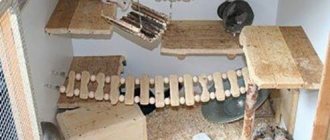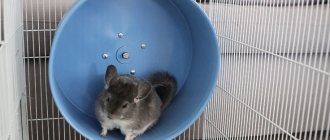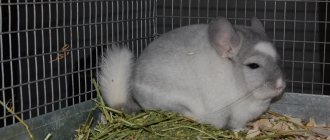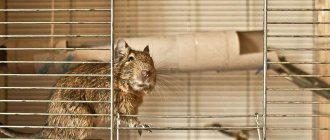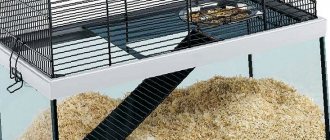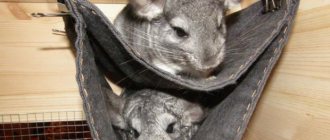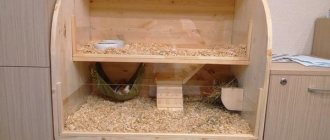Cage requirements
A chinchilla cannot be placed in the first cage that comes along. Representatives of this family of rodents are very demanding in terms of living conditions. Therefore, when purchasing a cage, there are several key points to consider.
Dimensions
Chinchillas are very active animals. They have powerful hind legs, with which they can easily jump and climb vertical surfaces. Therefore, the fluffy will need spacious housing. The optimal cage size for keeping one chinchilla is considered to be 25x30x80 cm. If you plan to buy 2 chinchillas at once, then these parameters are accordingly increased by 2 times.
To prevent your pet from feeling cramped, it is better to buy a two- or three-tier cage. In nature, chinchillas live in highlands, so they will like the presence of upper floors.
Material
Currently, in pet stores you can find cages for rodents made of wood, plastic and metal. Experienced breeders recommend choosing the latter option. This is explained by the presence of several significant advantages in metal structures:
- metal is an absolutely safe material because it does not release toxic compounds into the air;
- metal structures are the most durable - they can withstand even the strong teeth of a chinchilla;
- metal does not absorb odors at all;
In addition, metal structures are very easy to care for. Any dirt can be easily removed from their surface. Therefore, washing the cage usually takes no more than 15-20 minutes.
Other
In addition to the size and material of manufacture, there are additional requirements for a cage for keeping a chinchilla. For example:
- It is better to choose a design with a pull-out tray . This will allow you to replace the filler in literally 5 minutes, without disturbing your pet.
- The distance between the cage rods should not exceed 2 cm . The chinchilla skeleton easily compresses, stretching in a vertical direction. Therefore, with wider gaps, the probability of escape is high.
- The cage must be well ventilated . Only the bottom and/or back wall can be solid. Chinchillas do not tolerate stuffiness and high temperatures very well. Therefore, nothing should interfere with intensive air circulation.
- The entrance to the cage should be spacious enough so that the owner’s hand with the pet sitting on it can easily pass through it.
Also, the chinchilla's cage must be safe. Before letting the animal inside, you need to make sure that there are no broken or protruding rods or other sharp interior elements.
Chinchilla display
Nowadays, more and more chinchilla owners prefer to keep their pets in specialized display cases. This type of home for rodents differs from a cage in size, material of manufacture, the presence of several floors and large doors. Showcases for keeping chinchillas have both their pros and cons:
Advantages and disadvantages
wood is the most environmentally friendly material, closest to natural living conditions;
Wooden structures make it convenient for fluffies to grind down their teeth;
the display cases are spacious enough to give your pet room to spread out;
Chinchillas kept in display cases produce less noise.
wood has high adsorbent properties, so the smell of urine will emanate from the display case over time;
the display case is less ventilated;
wooden structures cannot be washed with household chemicals.
It is worth noting that modernized display cages made from profiles or combined materials have recently appeared on sale.
How much does it cost to house a chinchilla?
Buying a cage is quite an expensive undertaking. To purchase a standard design you will need from 3 to 5 thousand rubles. Prices for display cages have no limits at all. Even for a modest house for a pet you will have to pay 5-7 thousand. And for a spacious, equipped display case with an interesting design, manufacturers will ask from 20 to 30 thousand.
In order to save money, you can look for a cage or display case for a chinchilla on specialized ad platforms such as Avito or Yula. Former furry owners sell used cages for 2-3 times cheaper.
Main characteristics of a cage or display case for a chinchilla
A cage or display case for a chinchilla should have a number of characteristics:
Firstly, it must be well ventilated.
Secondly, you should pay attention to the material from which it is made. It can be metal, wood or plastic. We recommend purchasing a house made of metal. This, by the way, is the most budget option and is perfect for keeping an animal at home.
Chinchillas are rodents, and they will definitely try everything, so the material of the cage and its contents must be safe and reliable . Therefore, it is recommended to buy a cage with galvanized rods.
The permissible distance between the rods is 2 cm, which will ensure the safety of the animal.
If you get two chinchillas at once, we recommend purchasing a display cage, because it is the most spacious. The minimum size of the display case for each animal is 80x80x50 cm. They are made of laminated chipboard or aluminum. Choose what you can afford, but keep in mind that aluminum is more reliable, and a display cabinet made of laminated chipboard will most likely fit much better into the interior of your apartment.
The size of the display case you need depends on the number and gender of your future pets, because if you get two animals of different sexes at once, then they will definitely have offspring soon, which means that there should be even more space in the house. In the display case it is necessary to place several shelves, a hammock, and houses for animals.
And don't forget about ventilation! In a cage made of twigs, this does not arise, but if you purchased a display case, then a mesh should be installed on one or both sides, then the air will spread throughout the house, and the animal will be comfortable!
What structures cannot be used
Sometimes chinchilla owners, trying to save on the purchase of a specialized cage, keep their pets in structures that are completely unsuitable for this. Under no circumstances should you use the following as a home for chinchillas:
- Small cages - furry cats need space to move freely.
- Plastic containers and glass jars. Firstly, such structures are too cramped. Secondly, jars and containers do not allow air to pass through well, which is dangerous for the health and even the life of chinchillas.
- Carrying. Such structures are intended only for short-term transportation of animals.
Some chinchilla owners manage to place fluffies even in large cardboard boxes. But a pet will literally chew such a flimsy house within a day.
How to make it yourself
It is not at all necessary to spend money on buying a home for a chinchilla. You can make a high-quality cage with your own hands. To work, you will need to prepare the following tools and materials:
- laminated chipboard sheets;
- screws and screw ties;
- galvanized mesh;
- PVC tape;
- planks;
- screwdriver;
- glass 5-6 mm thick and hinges for it;
- drill;
- jigsaw;
- pliers;
- marker.
Making a cage at home is not as difficult as it seems at first glance. The main thing is to strictly follow the instructions below. The algorithm of actions is as follows:
- First you will need to draw up a drawing to scale. In this case, it is necessary to provide not only the size of the cage, but also the presence of free space in the finished structure, without which an active pet will experience discomfort.
- Then, using a marker, you need to make markings on the chipboard sheets and cut out the side walls, bottom and roof to the appropriate sizes. In the parts that are intended to accommodate the door and mesh, you will need to cut out the middle using a jigsaw, leaving only the frames.
- The mesh must also be cut with pliers, after which it must be secured to the side walls using self-tapping screws.
- To make a pallet, you need to cut out the bottom and sides 9-10 cm high from laminated chipboard, which are connected to each other with self-tapping screws. To add strength to the resulting structure, it is better to glue a strip from below.
- It is necessary to place the side and back walls into the resulting pallet to make sure that everything fits in size. Then connect the parts using a drill and screw ties.
- Then you need to attach the bottom and ceiling to the resulting base, and install hinges on the doors that will hold the glass.
- Next, you can work on the interior - fix all the planned shelves and ladders inside.
The final stage of work is cladding. You will need to hide the screws using plugs, and then seal all the edges of the assembled display case with film.
Tools and materials
Before you begin construction, you need to select the material to create the cage. Wood is best suited for this, as it is a pure biological material. It is also easy to process.
All sorts of sticks and small boards will not be lost. They can fit perfectly into the animal’s play area.We cover the frame with rods or mesh with small cells. We paint it well so that corrosion does not occur, and the house will serve you for many years.
Read here - How to decorate felt boots with your own hands? 80 photo ideas for inspiration. Tips from craftswomen on how to decorate felt boots using embroidery, beads, and applique
We will build the cage using metalworking tools:
A drill will help you drill or connect wood together. Also, for its full operation, drills are needed.
To cut wood, do not forget a saw - a hacksaw.
Check it out here too!
- Do-it-yourself barbecue from a gas cylinder: step-by-step instructions, choosing the optimal sizes and tips for choosing projects (110 photos)
Do-it-yourself winter chicken coop: design, layout, insulation, heating. 80 photos of warm chicken coops
How to make a snow blower with your own hands: manufacturing methods, diagrams, drawings, construction options and application nuances (100 photos + video)
Nailing nails of different sizes is done with a hammer. It's also worth taking for work.
To make the product as even as possible, we help ourselves with a level. All measurements are taken with a ruler.
You can mark dimensions on the material with a pencil or marker. A utility knife can also be useful for small work activities.To make your work easier, take a jigsaw. If you don’t have it because you don’t need it, it is advisable to ask your neighbors or friends so as not to spend extra money.
Cutting out metal parts is carried out with special scissors.
For a new design, it is better to purchase locks, latches and hinges in hardware stores to be sure of their strength and your animal cannot get free.
Check it out here too!
How to make a pump with your own hands - step-by-step manufacturing of a pump and options for making simple and effective pumps (95 photos + video)- Do-it-yourself hot smoked smokehouse: 100 photos, review of the best drawings, project selection and construction options
- How to make a cage for a parrot: basic requirements, tools and materials, step-by-step photo instructions. Tips from experts on arranging a cage
Pull-out shelves, all kinds of wheels and various metal hinges - you need to stock up on everything you need. But we make the chinchilla cage itself with our own hands.
Where to put the cage
Once the cage is ready for the furry to move in, you will need to choose a suitable place to install it. This point is very important, since chinchillas are very sensitive to environmental conditions. Therefore, when choosing a place to install the cage, you need to consider the following recommendations:
- The room should be cool. The optimal temperature for keeping a chinchilla is +18-22ᵒС. When the indicator increases to +24-25ᵒC, the pet’s well-being noticeably worsens. Chinchillas naturally live in the mountains, where the climate is quite harsh, so they do not tolerate heat well.
- The air humidity in the room should be between 45-50%. The fact is that chinchillas have very thick and dense fur, which instantly gets wet in high humidity. At the same time, the fur coat of fluffies takes a very long time to dry, which often becomes the cause of colds.
- Chinchillas are very timid, they fall into a stupor at every foreign sound or at the sight of a stranger. Therefore, it is better to install the cage in an isolated, non-passable room, where no one and nothing will disturb the pet.
- It is necessary to protect the chinchilla cage from direct sunlight. Chinchillas are crepuscular animals and prefer to sleep during the day. Therefore, it is better to place the cage in a shady room. If this is not possible, it is necessary to protect the windows with thick curtains or blinds so that the sun does not interfere with the animal’s rest.
It is also worth considering that the activity of chinchillas increases noticeably at night. Therefore, people who are sensitive sleepers should avoid installing a cage with a pet in the bedroom.
To ensure that your chinchilla always feels comfortable, it is recommended to install a split system in the room with the cage. You just need to install the air conditioner in such a way that cold air does not fall directly on your pet.
Construction
We start after purchasing materials. If you are making a cage at home, then equip and prepare the place in advance. A sufficient amount of light is necessary, as the work will take a lot of time.
We create a drawing of our cell and transfer the dimensions there. Do not rush to cut out parts; it is better to check all the measurements several times.You can watch different videos on how to make a cage for chinchillas to have an accurate idea of the work ahead.
We cut out a rectangle from this material to size - this is the future base of the cell. It must be covered with clapboard or a plywood sheet on top.
Check it out here too!
- Do-it-yourself trolley - how and from what to build a decorative and tool trolley (135 photos and videos)
DIY nests for laying hens: drawings, tricks, best solutions and tips on how to make nests correctly (115 photos and videos)
How to hem felt boots with your own hands: materials, tools, useful tips for hemming. Step-by-step instructions with photos + master class with video!
We install a removable tray on the base. If you decided in advance that it will not be there, you need to treat the material with water-repellent substances. Because chinchillas will go to the toilet and water may spill from the drinking bowl.
We vertically fasten the bars with self-tapping screws, ties or nails to the base in the corners. This way we will create the frame of our cell.
The top of the frame is done in exactly the same way. You can install an additional horizontal belt. This will strengthen the structure and help create additional shelves.
Metal rods or mesh are stretched over the frame. We fix it with nails or screws to the base. Make sure that there are no sharp protrusions sticking out anywhere that could injure the animal. To do this, you can install a metal strip.
Cleaning will be easy if you have several doors and a top that can be removed. We fasten the doors with hinges purchased at the store. We make frames from lining.
If the building has several floors, it becomes necessary to place stairs between floors. It will be much more fun and interesting for the animal to live in a house equipped with various loopholes and labyrinths.
Use your imagination when creating these things, but don't make them too small. Otherwise, you will have to destroy your product while rescuing the stuck animal.
Chinchillas are very sensitive rodents and even a small draft can provoke illness. To prevent this from happening, we cover two adjacent walls with wood. It is better to place the cage approximately 50 cm from the floor.
You can make a convenient shelf or frame. It may contain toys and care products. Do not install it near furniture or interior items. The animal can spoil them
We buy treatment products from construction or pet stores. You need to coat the inside with the solution to ensure that your chinchilla has an antibacterial living environment.
The outer part of the structure is varnished or painted. These are important measures to protect metal from corrosion and wood from rotting.
After reading our article, you can understand that it is not at all difficult to build a cage for a chinchilla with your own hands.
Arrangement of the cage
In order for a chinchilla to feel comfortable, the cage must be properly equipped. To do this, you will need to install the following accessories inside:
- House . In natural conditions, chinchillas are nocturnal and spend time during the day in rock crevices and burrows. Therefore, they need to have a shelter where they can hide from the sunlight and take a nap. Today, pet stores sell both plastic and wooden models. The first are more practical, the second are environmentally friendly. Therefore, if possible, you can buy a wooden house and change it every 2-3 months.
- Drinker and feeder . You can use regular metal or plastic bowls as dishes for your chinchilla. However, the animal will constantly carry them in its teeth, scattering food and spilling water. Therefore, it is better to buy specialized feeders and drinking bowls at the pet store, which are firmly fixed to the cage.
- Sennitsa – hay forms the basis of the chinchilla’s diet. Therefore, it should always be in the cage in unlimited quantities and freely available to the animal. An inverted running wheel attached to a cage frame is usually used as a hayride.
- Equipment for exercises . During wakefulness, chinchillas do not like to sit still. They are on the move, playing, exploring the world around them. Therefore, to prevent the animal from getting bored, it is necessary to install a so-called play complex for it in its cage. It can include a running wheel, ladders, tunnels and just small wooden toys. Also, the cage must have 3-4 wooden shelves - chinchillas simply love to sit on them.
- Hammock . So that the fluffy can take a little rest after active games, it is recommended to hang 2-3 hammocks in the cage. If desired, the chinchilla can even take a nap in them.
- Mineral stone . Chinchillas' teeth grow continuously, so they need to be constantly ground down. In nature, the animal sharpens its teeth on twigs and tree bark. And for these purposes, you can put a special mineral stone in the cage, which is sold in any pet store.
- Bathing suit . Because of their thick fur, chinchillas never take water treatments or even lick their fur. In order for your pet to be able to remove dirt and hairs that have fallen out of its coat, it is enough to place a bathing suit covered with sand or volcanic ash in the cage every day for 20-30 minutes.
- Tray . Chinchillas are quite smart animals. Therefore, with some effort and spending very little time, you can train your pet to go to the toilet in the same place.
Also, when keeping a chinchilla, you will have to buy food and litter on an ongoing basis. The latter should be in the form of corn pellets or sawdust.
Just under no circumstances should you put pine filler into a chinchilla’s cage, as it can cause allergies in the fluffy one.
The choice of food must also be approached responsibly. To ensure that your pet always feels good, you should give preference to specialized mixtures for feeding chinchillas, consisting mainly of herbs.
What kind of cage should a chinchilla have, how to choose and how to make a house for a pet with your own hands - all these questions need to be studied before purchasing a pet. Then the owner of the animal will have time to carefully prepare for the meeting of a new family member.
Do-it-yourself housing for a chinchilla
Often breeders decide to make a chinchilla cage with their own hands.
If you have a desire to tinker, then here are a few instructions to help you. First, buy the necessary materials for the job. It is better to give preference to wood. The frame will be made of bars, lining, boards and many shelves. Chipboard or plywood are also suitable. To close the holes, you need a metal mesh.
The following tools will be useful:
- hacksaw;
- jigsaw;
- hammer;
- drill and wood bits;
- stationery knife, marker;
- metal scissors;
- ruler.
To begin, prepare a drawing, taking into account the size of your room and the size of the desired pet house. Then start making the base, which needs to be covered with clapboard.
Next, the cage frame is built from the bars.
The bars are attached to the corners of the base using self-tapping screws or nails.
Using a metal mesh, the walls of the cage and its roof are tightened.
To make cleaning easier, we recommend making several doors on different sides.
Then you can install various shelves and place the accessories your animal needs on them.
It is best to cover the back of the cage with a sheet of plywood.
Finally, it is necessary to treat the house with a protective impregnation.
If you show your imagination, you can use old furniture and other available materials. An old cabinet is often used:
- The doors are removed from the furniture and the inside is repurposed for animals. Some of the shelves are cut out to allow animals to move freely.
- You need to cut a hole in the top of the closet and stretch the mesh so that the house is ventilated.
- In place of the cabinet doors, you can make frames from wood and tighten them with a metal mesh.
A do-it-yourself chinchilla display “from scratch” will require a little more time and skill.
So, you will need:
- metal tubes for the frame, or wooden yards;
- corners to connect parts;
- cogs;
- metal mesh;
- door hinges.
Then follow the instructions step by step:
| Step | Description |
| 1. | First you need to prepare drawings, taking into account the minimum acceptable dimensions for a chinchilla cage. |
| 2. | Next, we assemble the frame from pipes and yards, using corners for reliability, and fasten them with screws. |
| 3. | Make (internal) markings, designating areas for the animal’s life, that is, think about a place for sleeping, playing, toilet, bath, etc. |
| 4. | The mesh bottom is attached to the cage frame. For this you need a welding machine. |
| 5. | Connect the frame and walls of the house. |
| 6. | Next you need to install the door, use hinges and a lock. |
| 7. | Attach accessories inside the house. |
A do-it-yourself corner display case for a chinchilla is quite popular, because it can significantly save space in your apartment. To make one, show a little imagination and dexterity, and the result will definitely please you!
Where to place a chinchilla cage
Take seriously the choice of place in the apartment where the cage with the animal will be placed. It is better not to change the location of the cage throughout the animal’s life.
Here are some tips for you:
- the room should be dry and light;
- direct rays of the sun should not enter the cage;
- drafts should not be allowed;
- the air temperature where the animal lives should not exceed +23° C.
- the cage should not be placed next to electrical heating appliances;
- It is not advisable to place the cage on the floor;
- the cage should not be placed next to loud devices (equipment);
- Since chinchillas are very active at night, you should not place the cage in the bedroom. It's better to put it in the living room.
Cleaning a chinchilla's cage or display case
It is not enough to simply make a house, choose a place for it and move your pet into it; you must also not forget about caring for your pet’s home. Once a week you need to do a general cleaning, and at this time the animal should be placed in a carrier. The house can be wiped with a wet cloth and even vacuumed. At the end of cleaning, you need to wipe the cage dry. Disinfection (if necessary) is carried out using specialized products purchased at a pet store.
